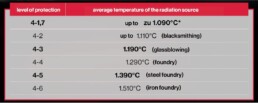Infrared radiation, or thermal radiation, was discovered in the year 1800 by Friedrich Wilhelm (William) Herschel, musician and astronomer. Everyday sources of infrared radiation include:
- sunlight (approx. 50%)
- infrared lamps to relieve pain and promote good circulation
- infrared heaters
- remote controls
- open flames
In professional settings, employees working in glass production and the processing of metals or plastics are among those exposed to the potentially harmful effects of infrared radiation, which is invisible to the naked eye. This article will set out the dangers posed by infrared, list the areas in which IR radiation is found and provide clarification on effective measures to tackle the problem.
What is infrared radiation?
Infrared is radiation with a wavelength between 780 nanometres and one millimetre on the electromagnetic spectrum. This IR radiation cannot be perceived by the naked eye, even if the heat emitted by the radiation can be felt. Particular caution is therefore required when dealing with extremely warm and prolonged radiation. Infrared light is divided into three types depending on the wavelength: IR-A, IR-B and IR-C. The longer the waves of the IR radiation, the less able they are to penetrate fabric or dermal layers. At 780 nm to 1,400 nm, the comparatively short-wave IR-A radiation is therefore the most harmful type in terms of human health (greatest degree of penetration). UV light is also invisible, but its wavelength spectrum is below 400 nm and it therefore has a shorter wavelength than radiation within the visible range of the spectrum.

In industrial settings, infrared is emitted from sources such as ovens or when cutting and welding metal.
What effect does infrared radiation have on the body?
Depending on its intensity, proximity and the duration of exposure, infrared radiation can be harmful to the eyes as well as to the skin. The eyes generally react much sooner and are much more sensitive than the skin to the effects of IR radiation, which can be harmful from a certain degree of intensity and exposure. The heat can in fact be beneficial to skin to a certain extent: infrared heat in the form of infrared lamps is used for medical purposes such as treating pain, circulation problems, stiff joints, inflammation etc. However, excessive heat can also cause heat cramps, heat exhaustion, heatstroke and burns.
Particular caution is advised in the event of infrared coming into excessively long direct contact with the eyes because its harmful effect on eye health varies depending on how deeply the IR radiation manages to penetrate the eye tissue:
- IR-A radiation with its excessive heat can cause irreversible damage (such as burns) to the retina and cloud the lens, which can lead to a cataract (also known as glassblower’s cataract or infrared cataract).
- IR-B radiation can damage the blood vessels down to the fatty tissue.
- IR-C radiation only reaches the surface of the cornea and skin and is less harmful.
As well as the acute risks posed by overheating, the chronic effects of infrared light on the eyes (damage to lenses and retina) are good reason to wear appropriate personal protective equipment when working with infrared radiation.
In what areas is infrared radiation used?
Aside from the aforementioned situations in people’s personal lives, there are many industrial settings in which infrared radiation is used in a variety of ways. Typical examples include:
- metal working (welding, cutting, smelting)
- glass production (melting and shaping, maintenance work on machinery)
- processing of plastics (extrusion, shaping)
- chemical industry (drying processes, reactors)
- food processing (baking, roasting, drying)
- electronics industry (soldering, tempering)
- construction (tarmac production, brick making)
- production of medical equipment (laser cutting, sterilisation processes)
- energy production (thermal power stations, solar energy)
Infrared is therefore involved in many processes where materials need to be brought to high temperatures.
Infrared radiation – how can I protect my eyes?
When it comes to the long-term dangers posed by infrared radiation, the key question is how to provide employees with effective, reliable protection to keep them healthy while they work.
What are appropriate measures to protect against the harmful effects of infrared radiation?
Whether you work right in front of a furnace in a foundry or a certain distance away, appropriate eye and face protection – plus where necessary the right heat protection clothing – are essential for you to be able to work safely.
If you operate in areas with particularly high levels of infrared radiation – right in front of the iron-melting furnace, for instance – heat protection clothing and special heat protection are indispensable.
For workplaces where less-intense heat sources do not pose an immediate threat but lasting exposure to infrared poses a hazard, uvex has developed a special range of safety spectacles to provide protection from IR radiation: uvex IR-ex. Combining safety with a clear view, these safety spectacles have the following impressive properties:
- Our infrared PPE covers the following infrared levels of protection for safety spectacles: 4C-1.7, 4C-3 and 4C-5 in accordance with EN 171.
- Colours, such as important warning and signal lights, are perceived without distortion because the lenses are tinted with a slight grey – not green or blue.
- The spectacles are highly transparent yet offer a very high level of IR protection.
- The safety spectacles also block UV radiation up to 400 nanometres (UV400).
- The infrared spectacles comply with EN 171, EN 169 and EN 170. They can therefore be worn for IR protection, welding protection, glare protection and UV protection.
- The lenses of the infrared safety spectacles are extremely scratch resistant on the outside with lasting anti-fog properties on the inside (KN) for an optimum view – even right by the heat source.
- The mechanical strength (FT) of the spectacles also allows them to withstand mechanical risks in extreme temperatures.
Our infrared safety spectacles feature our proven uvex supravision coating technology to pair top protection with a superbly clear view! Choose from the sporty uvex pheos cx2 and the uvex super f OTG as overspecs for prescription spectacle wearers. Experience the quality of our infrared spectacles for yourself and try out the colour recognition on our uvex IR-ex page!
How do I determine the right level of protection against infrared radiation for my workplace?
A pair of uvex IR-ex spectacles can provide you with optimum protection against the effects of infrared in your workplace. To determine which spectacles have the correct level of protection, establish the average temperature of the source of radiation – i.e. the burning object (such radiation measurements are performed as part of the workplace risk assessment in larger companies). The table provided sets out the official levels of protection of the relevant EN 171 standard and the level of protection that uvex infrared spectacles offer:

In the infrared light risk assessment for your workplace (for eyes and skin), your distance from the source of radiation and the amount of time spent in front of the radiation source are also relevant in determining the strength of your IR radiation exposure.
Legal requirements for infrared protection
All filters of the infrared safety spectacles and of other PPE in this range must meet the transmission requirements of EN 171 and are divided into defined levels of protection accordingly. Standard 166 for general personal eye protection stipulates further requirements for infrared safety spectacles. You can find illustrations and other explanations of these specifications and the applicable standards for safety spectacles on our website.
Our top-of-the-range uvex IR-ex infrared safety spectacles meet these three standards:
- EN 171 for infrared protection
- EN 169 for welding protection
- EN 170 for UV protection
Our infrared light spectacles also meet the requirements of U.S. standard ANSI/ISEA Z87.1 and Japanese standard JIS T8141. This multi-certification allows our infrared spectacles to be used for protection when welding and from solar radiation as well. Conversely, a pair of welding safety spectacles does not provide sufficient protection against infrared!
What is the difference between welding safety spectacles and infrared safety spectacles?
First of all, welding spectacles and infrared safety spectacles are subject to two different safety standards: while welding spectacles are designed specifically for welding applications and the respective output from the welding machine in accordance with EN 169, infrared safety spectacles are designed in accordance with EN 171; this standard intends for the eye protection to be selected according to the average temperature of the radiating heat source.
Comparing the two standards and the protective effect mentioned therein of welding safety spectacles and infrared safety spectacles, it quickly becomes clear that IR spectacles are capable of absorbing five to ten times more radiation within the 700 to 2,700 nm spectrum than welding spectacles – while still allowing just as much visual radiation through. Our professional uvex IR-ex infrared safety spectacles therefore provide effective protection when working with both types of radiation, meet both standards (EN 169 and EN 171) and are way ahead of welding spectacles when it comes to the protection that they offer. And, because our IR-ex spectacles also provide protection from UV radiation up to 400 nanometres, the requirements of EN 170 for UV filters are also met. Our IR-ex tint therefore offers multiple types of protection for virtually all hazards posed by optical radiation. This multi-certification allows our infrared spectacles to be used for protection when welding and from solar radiation as well. Conversely, a pair of welding safety spectacles does not provide sufficient protection against infrared!
Effective protection against infrared radiation from uvex
Protect your eyes and those of your employees when working with infrared radiation: rely on the durability, transparency and colour fidelity of uvex IR-ex safety spectacles! Use the temperature of the radiation source to determine the correct level of protection, and please do not hesitate to contact us if you have any questions. You can contact us by telephone (+49 (0)911 97 36 360), by email (serviceteam@uvex.de) or via our contact form.
You can find more information on our professional IR products in our online brochure for uvex IR-ex. We also have glare safety spectacles, welding safety spectacles and UV safety spectacles in our range. You can also use our handy tint app to help you to select the correct tint.
